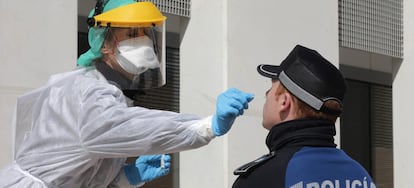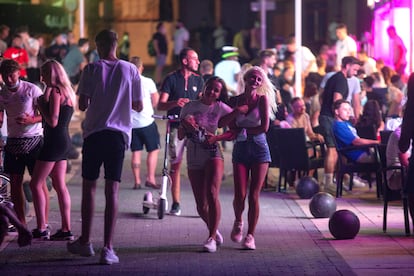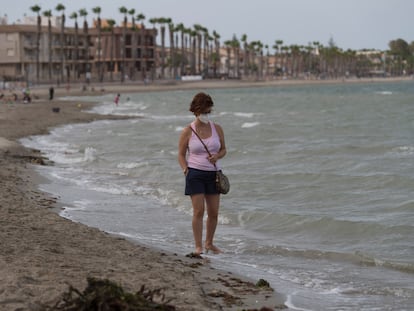Coronavirus incidence in Spain triples in just over two weeks
According to the Health Ministry, there are now more than 200 active outbreaks in the country


Coronavirus cases in Spain have soared in just over two weeks, according to the latest figures from the Spanish Health Ministry, which were released Monday after a three-day delay. The cumulative incidence of Covid-19 is now 27.39 cases per 100,000 inhabitants, a sharp rise from the 8.76 cases per 100,000 reported on July 3.
The cumulative incidence of the virus is nearly the same as it was on May 11, when Spain began to deescalate the lockdown rules that were introduced in mid-March in a bid to curb contagion. From that date on, the figure began to slowly fall, reaching a record low on June 25, with 7.74 cases per 100,000 inhabitants. But since then, the figure has steadily risen. This increase happened slowly at first but a significant spike was detected last week.
According to data from the World Health Organization (WHO), Spain is the only European country – with the exception of small states like Luxembourg and countries that do not belong to the European Union – where the number of coronavirus cases is on the rise. On Sunday, the organization reported that the 14-day cumulative incidence in Spain had doubled in two weeks, representing a rise of 103%. Only Israel (147% increase), Luxembourg (151%), Montenegro (161%) and Kyrgyzstan (354%) recorded a higher two-week spike in the incidence of coronavirus.
According to Fernando Rodríguez Artalejo, the spokesperson of the Spanish Epidemiology Association, cumulative incidence is one of the best ways to measure the evolution of the epidemic. Measurements in rates (cases per inhabitants) are more accurate than absolute numbers, he explains, and cumulative rates are even better because they consolidate the data and soften daily discrepancies that are often unrelated to the transmission of the disease, for instance the underrreporting over weekends.
Uneven situation

Health Minister Salvador Illa reported on Monday that there were 201 active coronavirus outbreaks in Spain, with 2,289 associated cases. But the situation in the country is very uneven. According to Rodríguez Artalejo, the outbreaks in the Spanish regions of Aragón, Catalonia and Basque Country are of most concern. “The situation in these regions is very worrying,” he explains. “If they are not controlled immediately and thoroughly, we will have a very complicated situation.”
In Aragón, the incidence of coronavirus is at 160 cases per 100,000 inhabitants, up from 98 last week; in Catalonia, the rate rose from 63 on Friday to 84.5 on Monday, and in Basque country, the figure nearly tripled in the same period: jumping from 16 to 35.5.
“To understand the increase in the incidence [of coronavirus], we have to see to what extent it is due to Aragón and Catalonia, and if, excluding these regions, they [the cases] correspond to well controlled outbreaks, which appears to be the case,” says Rodríguez Artalejo.
Spanish epidemiologist Ildefonso Hernández agrees: “The rest of the regions are not bad, some are following a downward trend like Castilla y León, Madrid, Galicia and Extremadura, where there was a spike last week which appears to have stabilized.”
Regional authorities in both Aragón and Catalonia reintroduced lockdown measures in an effort to slow the rising number of cases. In Aragón, four comarcas – a traditional administrative division in parts of Spain – were moved back to Phase 2 of the coronavirus deescalation plan. And in Catalonia, residents in Barcelona and its metropolitan area, the Lleida comarca of La Noguera and a number of municipalities in Segrià, have been advised to stay at home and limit travel. Social restrictions, including limits on the capacity of bars and restaurants, and the closure of nightlife venues, cultural activities and gyms, have also been introduced.
On these restrictions, Rodríguez Artalejo, says: “We know that strict confinement is very effective. But nobody knows how effective these other measures are. There is not enough research on them. It will take longer for them to produce results, but we don’t know how much longer.”
Illa said on Monday that the central government supported the semi-lockdown in Catalonia and called on residents in the affected areas to respect the measures.
Social gatherings

While several outbreaks in Spain are linked to infections among seasonal workers in Aragón and Catalonia, many others are connected to social gatherings and parties. “These days we are seeing an increase [in cases] due to nightlife activities, parties and social gatherings. They are situations that are beginning to especially worry us because they are more difficult to control,” said María José Sierra, from the Health Ministry’s Coordination Center for Health Alerts, on Monday.
In Andalusia, the number of coronavirus cases linked to a party at a nightclub in Córdobas rose to 83. In Murcia, the regional government closed all nightlife venues, with 40 infections detected. And in the Basque Country, in the municipality of Ermua, the capacity at bars has been reduced to 50% after an end-of-school-year party led to a coronavirus outbreak, with 23 new cases reported on Monday, bringing the total to 48.
Contact tracing
According to a report from the Carlos III Health Institute, Spain is only detecting an average of one contact for every confirmed coronavirus case. The document, dated July 15 and up to date until May, points out, however, that there is a big discrepancy in tracking capacity among the regions. In Canary Islands, for instance, six contacts are detected for each Covid-19 case, and in Andalusia, Extremadura and Navarre, the figure is five.
“The figure is scandalously low, it’s hard for me to believe it,” says Rodríguez Artalejo, who adds that failure to track contacts could worsen the situation in Catalonia.
“How many contacts are they tracking per case?” he asks. “In what percentage is the source of the contagion identified? It would be very good if it were 80%, but with 20% it would be very problematic.”
According to data provided by regional health authorities – with the exception of Galicia and the Canary Islands – there are 3,533 contact tracers in Spain. This is the equivalent of one per 12,000 inhabitants, far below the recommended rate of one per 5,500 people. Another 8,500 professionals would be needed to meet this rate, estimates Álex Arenas, an investigator at the Rovira i Virgili University in Tarragona.
English version by Melissa Kitson.
Tu suscripción se está usando en otro dispositivo
¿Quieres añadir otro usuario a tu suscripción?
Si continúas leyendo en este dispositivo, no se podrá leer en el otro.
FlechaTu suscripción se está usando en otro dispositivo y solo puedes acceder a EL PAÍS desde un dispositivo a la vez.
Si quieres compartir tu cuenta, cambia tu suscripción a la modalidad Premium, así podrás añadir otro usuario. Cada uno accederá con su propia cuenta de email, lo que os permitirá personalizar vuestra experiencia en EL PAÍS.
¿Tienes una suscripción de empresa? Accede aquí para contratar más cuentas.
En el caso de no saber quién está usando tu cuenta, te recomendamos cambiar tu contraseña aquí.
Si decides continuar compartiendo tu cuenta, este mensaje se mostrará en tu dispositivo y en el de la otra persona que está usando tu cuenta de forma indefinida, afectando a tu experiencia de lectura. Puedes consultar aquí los términos y condiciones de la suscripción digital.
More information
Últimas noticias
Most viewed
- David King, chemist: ‘There are scientists studying how to cool the planet; nobody should stop these experiments from happening’
- Reinhard Genzel, Nobel laureate in physics: ‘One-minute videos will never give you the truth’
- Mexico completes its trade shift with the entry into force of tariffs on China and countries without trade agreements
- Oona Chaplin: ‘I told James Cameron that I was living in a treehouse and starting a permaculture project with a friend’
- Sinaloa Cartel war is taking its toll on Los Chapitos









































